The Importance of Swimming Pool Plaster for Your Pool Renovation

Every pool owner knows the importance of maintaining their swimming pool. One critical element in ensuring the longevity and attractiveness of a pool is the swimming pool plaster. This article will dive deep into understanding what swimming pool plaster is, its benefits, types, and why it should be a priority in your pool renovation plans.
What is Swimming Pool Plaster?
Swimming pool plaster is a finishing material applied to the interior surfaces of pools. Traditionally, it consists of a mixture of cement, sand, and water, often enhanced by additives to improve its durability and aesthetic appeal. The plaster is essential as it creates a smooth, waterproof barrier, protecting the underlying structure of the pool while providing an appealing finish.
The Composition of Swimming Pool Plaster
The formulation of swimming pool plaster can vary significantly based on brand and application. Common components include:
- Cement: The main binding element in the plaster.
- Sand: Generates texture and durability.
- Additives: Chemicals that improve workability, bond strength, and water resistance.
- Pigments: Used to impart color and enhance aesthetic appeal.
Why Swimming Pool Plaster Is Essential
Many pool owners often underestimate the importance of swimming pool plaster. Here are several key reasons why it should be at the forefront of your pool renovation plans:
1. Protection Against Water Damage
One of the primary functions of pool plaster is to act as a waterproof barrier. It protects the structure of your pool from water infiltration, which can lead to significant structural damage over time. Exposure to moisture without adequate protection can weaken concrete and lead to costly repairs.
2. Enhances Aesthetic Appeal
With a wide range of colors and textures available, swimming pool plaster can dramatically enhance the visual appeal of your pool. Whether you prefer a classic white finish or a vibrant blue, the right plaster can transform the look of your swimming area, creating a beautiful oasis in your backyard.
3. Smooth and Comfortable Surface
A properly applied layer of plaster creates a smooth surface that feels pleasant against the skin. This is especially important for families with children, as a comfortable surface can prevent scrapes and irritation during pool activities.
4. Increases Pool Longevity
Regular maintenance and application of swimming pool plaster can significantly extend the life of your pool. A well-managed plaster surface reduces wear and tear, keeping your pool enjoyable for years to come.
Types of Swimming Pool Plaster
There are several options when it comes to choosing the right type of swimming pool plaster. Each type has unique benefits, making it crucial to select the right one for your pool:
1. Standard White Plaster
Traditional white plaster is a widely used option and is the most economical. It offers a classic look but may require more maintenance over time due to its tendency to stain and discolor.
2. Colored Plaster
Colored plaster incorporates pigments that allow for various aesthetic options. You can choose shades that complement your backyard design, providing a personalized touch.
3. Pebble Finish
A pebble finish combines smooth pebbles with plaster, creating a textured surface that provides durability and a natural look. It is less slippery and can withstand heavy use, making it an excellent choice for busy pools.
4. Quartz Plaster
Quartz plaster involves mixed fine quartz aggregates with plaster, resulting in a stronger and more resilient surface. It's less prone to staining and fading, making it a popular choice for luxury pools.
Choosing the Right Swimming Pool Plaster for Your Pool
When considering swimming pool plaster, several factors will influence your choice, including:
- Budget: Determine how much you are willing to invest in your pool renovation.
- Location: Evaluate the pool’s environment. For example, pools in areas with harsher climates may require more durable plaster types.
- Pool Usage: Consider how frequently the pool is used and by whom. Higher traffic pools may benefit from stronger finishes.
- Aesthetics: Think about the overall look you want to achieve and how different plaster types will impact your pool's appearance.
Application and Maintenance of Swimming Pool Plaster
Applying swimming pool plaster is a crucial step that should be handled by professionals to ensure a flawless and durable finish. Here’s what to expect during the application process:
The Application Process
- Preparation: This includes cleaning and repairing the pool surface to ensure proper adhesion.
- Mixing: The plaster is mixed in precise amounts to achieve the right consistency.
- Application: Professionals apply the plaster, smoothing it out to create a uniform finish.
- Curing: After application, the plaster needs adequate curing time under controlled conditions to ensure its longevity.
Maintenance of Swimming Pool Plaster
Maintaining your swimming pool plaster is essential for preserving its beauty and functionality. Here are some tips for upkeep:
- Regular Cleaning: Routine brushing and cleaning help prevent algae buildup.
- Water Chemistry: Properly balancing the water chemistry can prevent staining and etching.
- Repairing Cracks: Promptly address any visible cracks or deterioration to avoid more extensive damage.
Signs That Your Swimming Pool Plaster Needs Renovation
Recognizing when your swimming pool plaster needs renovation is key to maintaining your pool. Look out for the following signs:
- Visible cracks or chips across the plaster.
- Stains that cannot be removed with regular cleaning methods.
- Rough patches that may be hazardous to swimmers.
- Excessive fading or discoloration.
- Pooling water or leaks indicating underlying structural issues.
Conclusion
Investing in swimming pool plaster is crucial for any pool renovation project. It not only enhances the beauty and comfort of your pool but also plays a significant role in protecting it from damage and prolonging its life. By understanding the various types of plaster, their benefits, and how to maintain them, you can ensure that your pool remains an enjoyable retreat for years to come.
When planning your pool renovation, consider reaching out to expert services like poolrenovation.com to ensure you get the best advice and application for your swimming pool plaster. With the right care, your pool can be a source of enjoyment and relaxation, perfect for family gatherings or quiet evenings under the stars.









